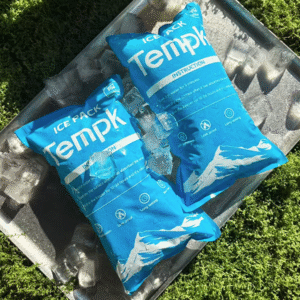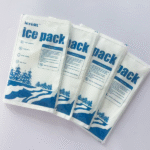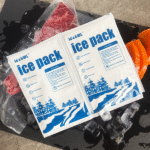Lembar Paket Es Kering Pendingin: Bagaimana Anda Memilih dan Menggunakannya 2025?
Jika Anda memindahkan barang yang sensitif terhadap suhu, A lembar paket es kering pendingin dapat menstabilkan jalur, memperpanjang waktu tunggu, dan menurunkan limbah. Anda memerlukan kisaran suhu yang tepat, menghitung, dan penempatan untuk mencapai target jalur Anda. Dalam panduan ini, Anda akan belajar cara mengukur, mengemas, dan memvalidasi, jadi paket Anda tiba sesuai spesifikasi dan tanpa membayar kelebihan berat.
-
Pilih a lembar paket es kering pendingin yang cocok dengan jalur dan muatan Anda
-
Jumlah lembar ukuran dengan penduga cepat dan contoh untuk durasi berbeda
-
Kemas dengan benar untuk menghindari titik panas dan kondensasi saat transit
-
Membandingkan lembar paket es kering pendingin vs paket gel, batu bata, dan es kering
-
Patuhi pelabelan dan ekspektasi keselamatan untuk pengiriman di bawah nol derajat
Apa itu lembaran kantong es kering pendingin dan mengapa menggunakannya?
Jawaban Langsung:
A lembar paket es kering pendingin adalah kisi-kisi sel tertutup yang fleksibel dan diisi dengan bahan pengubah fasa (PCM) dirancang untuk membeku di bawah 0°C dan memberikan pendinginan saat meleleh. Ini menggabungkan cakupan selimut “lay‑flat” dengan kinerja di bawah nol, membantu Anda membungkus produk terlebih dahulu, dinding garis, atau lapisan antar item. Harapkan gradien yang lebih stabil dan lebih sedikit sudut panas dibandingkan kemasan longgar jika kemasannya konsisten.
Penjelasan yang diperluas:
Bayangkan lembaran tersebut sebagai “selimut pendingin” yang Anda kondisikan sebelumnya seperti es. PCM memegang titik beku yang ditetapkan, jadi ia melepaskan a stabil aliran dingin saat berubah keadaan. Banyak lembar paket es kering pendingin pilihan kami menargetkan kisaran –5°C hingga –20°C untuk farmasi atau makanan beku. Anda dapat melipat atau memotong jahitannya agar sesuai dengan kotak, yang mempercepat garis dan mengurangi tenaga kerja. Di jalur persil yang sering terjadi serah terima, area kontak yang seragam membatasi lonjakan termal yang disebabkan oleh celah yang ditinggalkan oleh batu bata gel tunggal.
Lembaran paket es kering pendingin vs paket gel: yang berkinerja lebih baik?
Detail:
Paket gel serbaguna tetapi menghasilkan titik dingin dan dapat merosot. A lembar paket es kering pendingin menyebar dingin secara merata dan tetap di tempat Anda meletakkannya. Jika jalur Anda mengalami perubahan suhu dari pintu ke pintu dari 5°C menjadi 35°C, lembaran mengurangi risiko pemanasan tepi. Untuk jalur ekspor yang sangat dingin atau panjang, menggabungkan a lembar paket es kering pendingin lapisan dengan muatan es kering kecil untuk memperpanjang waktu penahanan sekaligus mengontrol laju sublimasi.
| Opsi Pendinginan | Kisaran Khas | Pengkondisian | Apa artinya bagimu |
|---|---|---|---|
| Paket gel | 0–8°C atau –2–0°C | 24–48 jam pada tekanan yang dikehendaki | Kontak sederhana namun tidak merata; mungkin memerlukan lebih banyak unit untuk menutupi kesenjangan |
| Lembaran kantong es kering berpendingin | target –5 hingga –20°C | 24–48 jam pada suhu target | Bahkan cakupan selimut; lipat agar pas; cocok untuk SKU campuran |
| Es kering (Co₂) | ~–78,5°C permukaan | Tidak dikondisikan; tangani dengan APD | Tahan lama untuk dibekukan; pelabelan hazmat; risiko pembekuan berlebih |
Tips dan saran praktis
-
Lonjakan panas pada mil terakhir: Bungkus bagian atas dan samping muatan dengan a lembar paket es kering pendingin untuk melindungi dari tutup yang terkena sinar matahari.
-
SKU campuran: Gunakan segmen lembaran di antara item-item yang memuat panas untuk menghindari kelompok yang memanas sendiri.
-
Jalur ekspor: Pasangkan satu lembar paket es kering pendingin dengan balok es kering kecil untuk meratakan perjalanan awal yang terlalu dingin.
Kasus nyata: Paket makanan daerah ditambahkan a lembar paket es kering pendingin atas protein dan hentikan pembusukan musim panas 7% ke 2% selama jendela gelombang panas 72 jam.
Berapa banyak unit lembaran kantong es kering pendingin yang Anda perlukan?
Jawaban Langsung:
Mulailah dengan perkiraan beban panas dan panas laten PCM. Kalikan total watt perolehan panas dengan jam yang Anda perlukan, lalu bagi dengan joule efektif lembar tersebut. Untuk sebagian besar pengirim terisolasi, yang memberikan pass pertama dalam ±15%. Tambahkan margin 10–20% untuk serah terima dan penangguhan akhir pekan.
Penjelasan yang diperluas:
Kotak Anda memperoleh panas dari suhu sekitar, kebocoran jahitan, dan menangani. A lembar paket es kering pendingin menyumbangkan “baterai dingin” yang dapat diprediksi berdasarkan panas laten pada titik perubahan fasenya. Jika jalur Anda menghabiskan waktu pada suhu 25–30°C, Anda membutuhkan lebih banyak kapasitas daripada rute musim semi yang ringan. Gunakan estimator di bawah untuk pengukuran cepat, lalu jalankan pengujian paket untuk memverifikasi.
Penaksir cepat untuk ukuran lembaran paket es kering pendingin
Aturan praktis satu kotak:
-
Kotak_U_nilai: perpindahan panas secara keseluruhan (W/m²·K) pengirim Anda
-
Permukaan_Area: daerah luar (m²)
-
Δt: ambien dikurangi target setpoint internal (K)
-
Lembar_Efektif_Joule: terpendam + energi yang masuk akal per lembar sesuai jangkauan Anda
| Contoh Skenario | masukan | Hasil | Apa yang harus dilakukan |
|---|---|---|---|
| 12 L EPS pengirim, ΔT=20K, 48 H | kamu = 0,6, SEBUAH=0,9m² | ~3–4 lembar | Mulailah dengan 4 lembar paket es kering pendingin unit dan validasi |
| 18 L pengirim VIP, ΔT=25K, 72 H | kamu = 0,18, SEBUAH=1,1m² | ~4–5 lembar | Mulailah dengan 5 lembaran; pertimbangkan satu lapisan atas dan bawah |
| 8 L EPS, ΔT=15K, 24 H | kamu = 0,7, SEBUAH=0,7m² | ~1–2 lembar | Mencoba 2 lembaran; menghapus 1 jika produk berisiko membeku |
Penempatan sama pentingnya dengan jumlah lembar
Detail:
Masukkan setidaknya satu lembar paket es kering pendingin di atas muatan. Panas meningkat di dalam kotak ketika bagian atasnya terkena sinar matahari, jadi cakupan atas mencegah efek “tutup hangat”.. Untuk muatan tinggi, tambahkan lembaran samping, atau lipat lembaran panjang menjadi bentuk U untuk menahan beban. Untuk barang beku, hindari kontak langsung dengan produk halus; tambahkan bantalan bergelombang.
Tips Praktis
-
Miring ke atas‑berat: Menggunakan 60% dari total lembar paket es kering pendingin massa di atas di jalur musim panas.
-
Kesenjangan lapisan: Sisakan ruang udara 3–5 mm di atas pencatat data sensor.
-
Barang lunak: Selipkan bantalan kraft atau busa di antara lembaran dan label karton untuk menghentikan keluarnya kondensasi.
Kasus nyata: Sebuah situs klinis memotong paket dari 7 ke 4 komponen setelah beralih ke a lembar paket es kering pendingin U-wrap dan tahan selama 48 jam dalam suhu ruangan 30°C.
Bagaimana seharusnya Anda mengkondisikan dan mengemas lembaran kantong es kering pendingin?
Jawaban Langsung:
Kondisikan pada tekanan yang dikehendaki hingga inti benar-benar beku. Paling lembar paket es kering pendingin model memerlukan waktu 24–48 jam dalam freezer –10°C hingga –20°C. Letakkan seprai rata, hindari menumpuk lebih dari 5 tinggi, dan verifikasi suhu inti sebelum digunakan.
Penjelasan yang diperluas:
Seprai yang dikondisikan dalam kondisi dingin menghasilkan semburan dingin singkat dan kemudian berperilaku seperti gel kental. Sepenuhnya beku, A lembar paket es kering pendingin memberikan output stabil selama berjam-jam di dekat titik perubahan fasenya. Gunakan termometer probe atau pistol IR yang aman untuk disentuh untuk mengonfirmasi. Beri label pada tas jinjing berdasarkan waktu masuk/waktu keluar untuk menjaga disiplin FIFO tetap berlaku.
Pengemasan langkah demi langkah dengan lembaran kantong es kering pendingin
-
Dinginkan kotak terlebih dahulu selama 10–15 menit jika memungkinkan.
-
Tempatkan satu lembar paket es kering pendingin di bagian bawah atau lewati jika produk sensitif terhadap pembekuan.
-
Tambahkan muatan dengan spacer untuk membuat saluran udara kecil.
-
Tirai a lembar paket es kering pendingin di atas; lipat ujungnya ke bawah.
-
Tambahkan seprai samping untuk jalur panas atau risiko akhir pekan.
-
Masukkan pencatat data di dekat sudut terhangat.
-
Menutup, segel, dan label.
| Sasaran Paket Keluar | Penggunaan Lembar | Kepekaan | Untukmu |
|---|---|---|---|
| Beku, 72 H | Dasar + atas + sisi | Rendah | Perlindungan beku yang kuat dengan a lembar paket es kering pendingin amplop |
| Santai, 48 H | Sangat berat, mungkin sisi | Sedang | Hindari lembaran bawah untuk mencegah titik dingin |
| Santai, 24 H | Lembar atas tunggal | Tinggi | Ringan, paket keluar berbiaya rendah |
Apakah Anda membutuhkan es kering juga?
Jika titik akhir Anda memerlukan pembekuan sekeras batu saat pengiriman, balok es kering kecil dapat dipasangkan dengan a lembar paket es kering pendingin di lapisan atas. Lembaran ini memoderasi guncangan termal awal; es kering memanjangkan ekor. Simpan CO₂ di bawah tutup yang memiliki lubang ventilasi dan tambahkan label yang sesuai.
Kasus nyata: Sebuah toko roti yang mengirimkan croissant berlapis ke seluruh negeri lembar paket es kering pendingin di atas lempengan es kering seberat 1kg. Mereka mempertahankan tekstur dan memotong keuntungan hingga setengahnya selama puncak liburan.
Bagaimana lembaran kantong es kering pendingin mempengaruhi kepatuhan dan keselamatan?
Jawaban Langsung:
Perlakukan pengiriman di bawah nol dengan memperhatikan risiko pembekuan, kondensasi, dan penanganan CO₂ saat ada es kering. A lembar paket es kering pendingin mengurangi CO₂ bebas, tapi Anda tetap membutuhkan sarung tangan, pelindung mata, dan hapus label jika Anda menambahkan es kering.
Penjelasan yang diperluas:
Untuk perawatan kesehatan, ikuti sistem mutu Anda untuk validasi kemasan, pemantauan suhu, dan kualifikasi jalur. Banyak tim menjalankan profil seperti 0–8°C hingga 72 jam atau profil yang dibekukan. A lembar paket es kering pendingin membantu melewati segmen tantangan dengan menghaluskan lonjakan, tapi dokumentasi tetap penting. Untuk makanan, mendokumentasikan bahwa suhu inti tetap berada dalam batas aman di seluruh jalur dan pada saat pengiriman.
Daftar periksa keselamatan untuk pengiriman lembaran paket es kering pendingin
-
APD: Sarung tangan berinsulasi saat menangani lembaran beku atau es kering.
-
Ventilasi: Jangan pernah menyegel es kering dalam wadah kedap udara.
-
Label: Sertakan “Beku” atau kisaran suhu; tambahkan pengidentifikasi CO₂ jika digunakan.
-
Tes jatuh: Konfirmasikan segel ditahan; A lembar paket es kering pendingin tidak boleh pecah jika terjatuh.
| Mempertaruhkan | Nonton apa | Mitigasi | Manfaat bagi Anda |
|---|---|---|---|
| Terlalu beku | Produk halus, Biologi | Bantalan pengatur jarak, hanya teratas lembar paket es kering pendingin | Mencegah hilangnya tekstur dan potensi |
| Kondensasi | Jalur lembab | Lapisi dengan polybag, bantalan penyerap | Lindungi label dan karton |
| Co₂ penumpukan | Campuran es kering | Jalur ventilasi, Label | Keamanan dan kepatuhan |
Biaya dan keberlanjutan: dimana lembar kantong es kering pendingin dapat dipasang?
Jawaban Langsung:
Total biaya pengiriman meningkat ketika Anda mengurangi pembusukan, tenaga kerja, dan berat DIM. A lembar paket es kering pendingin sering menggantikan beberapa batu bata gel dan mengurangi sentuhan pada jalur pengepakan cepat.
Penjelasan yang diperluas:
Seprai disimpan rata saat kering, meningkatkan kepadatan gudang. Anda dapat menyesuaikan ukuran dengan memotong sepanjang jahitan, yang menghindari sisa batu bata yang aneh. Jika pelanggan Anda mendukung pengambilan kembali, A lembar paket es kering pendingin dapat digunakan kembali setelah pemeriksaan, atau didaur ulang melalui aliran khusus tergantung pada filmnya.
Pengungkit keberlanjutan yang Anda kendalikan
-
Ukuran kanan: Gunakan sebanyak-banyaknya saja lembar paket es kering pendingin segmen sesuai kebutuhan.
-
Paket hibrida: Gabungkan lembaran dengan VIP ringan untuk mengurangi massa cairan pendingin.
-
Gunakan kembali program: Memeriksa, membersihkan, dan memindahkannya jika diperbolehkan.
| Tuas | Baseline | Dengan Lembar | Apa yang Anda Dapatkan |
|---|---|---|---|
| Massa pendingin | 4 Gel Bricks | 1 lembar paket es kering pendingin | Berat badan dan pengiriman lebih rendah |
| Langkah-langkah pengepakan | 7–8 tindakan | 4–5 tindakan | Jalur lebih cepat, lebih sedikit kesalahan |
| Volume penyimpanan | Batu bata yang lepas | Lembaran datar | Efisiensi kubus yang lebih baik |
Kasus nyata: SKU pendingin yang dikurangi oleh e‑grocery dari 6 ke 2 menggunakan a lembar paket es kering pendingin ditambah gel standar. Mereka menyelamatkan tiga posisi palet per minggu.
Validasi: bagaimana Anda membuktikan lembar paket es kering pendingin Anda berfungsi?
Jawaban Langsung:
Jalankan kualifikasi operasional (oke) dengan muatan terburuk dan profil musim panas Anda, kemudian menjalankan kualifikasi kinerja (PQ) di jalur hidup. Gunakan pencatat data di dalam sudut hangat dan dekat bagian atas.
Penjelasan yang diperluas:
Kondisikan terlebih dahulu lembar paket es kering pendingin pada setpoint yang direkomendasikan. Muat pengirim Anda ke muatan paling ringan yang Anda harapkan, yang paling cepat panas. Tantang dengan lingkungan yang panas. Jika profilnya bertahan, beban yang lebih berat akan lebih mudah. Untuk jalur beku, konfirmasikan bahwa SKU sensitif tidak membeku secara berlebihan.
Panduan cepat desain pengujian
-
Sensor: Satu di sudut yang hangat, satu di dekat bagian atas, satu massa tengah.
-
Profil: 24/48/72 jam bertahan dengan siklus lingkungan 25–35°C.
-
Penerimaan: Inti muatan dalam spesifikasi; tidak ada kebocoran yang meleleh.
| Langkah Tes | Tujuan | Lulus/Gagal | Untukmu |
|---|---|---|---|
| Profil panas OQ | Kasus terburuk | Dalam rentang suhu | Peluncuran percaya diri |
| percontohan PQ | Paket hidup | Dalam pita pengiriman | Bukti dunia nyata |
| Post-mortem | Akar penyebabnya | Perubahan yang bisa ditindaklanjuti | Iterasi lebih cepat |
2025 tren bagi pengguna lembaran paket es kering pendingin
Tinjauan Tren:
Di dalam 2025, tim pindah ke lembar paket es kering pendingin paket yang mengintegrasikan analisis jalur dan sisipan khusus SKU. Harapkan campuran PCM yang lebih fleksibel yang tahan –10°C hingga –15°C tanpa lapisan tipis yang rapuh, ditambah film penghalang yang lebih ringan untuk mengurangi DIM. Aturan pengepakan berdasarkan data menggantikan pengetahuan suku yang ada di tempat pengepakan.
Sekilas
-
Titik fase campuran: PCM yang disetel yang menjaga suhu tetap –12°C untuk kurva yang lebih mulus.
-
Daya tahan segel tepi: Lapisan film baru tahan terhadap siklus beku-cair yang berulang, memperpanjang lembar paket es kering pendingin digunakan kembali.
-
SOP Digital: Daftar periksa seluler yang menghitung jumlah lembar berdasarkan jalur dan waktu pengondisian log otomatis.
Wawasan pasar:
Kit makan, sampel klinis, dan toko roti regional masih banyak yang mengadopsinya. Keuntungan terbesar diperoleh dari penggantian tumpukan cairan pendingin campuran dengan yang terstandarisasi lembar paket es kering pendingin perlengkapan. Harapkan pengadaan untuk mendorong kompatibilitas multi-vendor, jadi pilihlah dimensi dan potong garis yang sesuai dengan pengirim umum.
Pertanyaan yang sering diajukan
Q1: Berapa suhu yang dapat dipertahankan oleh lembaran kantong es kering pendingin?
Sebagian besar memiliki jendela sempit di bawah nol, sering –5°C hingga –20°C. Pilih lembar paket es kering pendingin yang cocok dengan jalur Anda dan validasi dengan logger.
Q2: Berapa lama lembaran kantong es kering refrigeran bertahan dalam perjalanan?
Waktu tahan tergantung pada isolasi, ambient, dan jumlah lembar. Banyak jalur yang bertujuan untuk 24–72 jam. Mulailah dengan penduga, lalu sesuaikan milikmu lembar paket es kering pendingin menghitung.
Q3: Dapatkah saya mengirim hanya dengan lembaran kantong es kering berpendingin untuk dibekukan?
Ya, untuk jalur pendek dengan isolasi yang kuat. Untuk jalur ekspor yang panjang, menggabungkan a lembar paket es kering pendingin dengan muatan es kering yang kecil.
Q4: Apakah lembaran kantong es kering pendingin akan mendinginkan barang-barang sensitif secara berlebihan?
Bisa jika ditempatkan di bawah produk. Gunakan penempatan hanya atas atau bantalan pengatur jarak dengan Anda lembar paket es kering pendingin.
Q5: Bagaimana cara menyimpan dan mengkondisikan seprai?
Berbaring rata, hindari tumpukan tinggi, dan bekukan selama 24–48 jam pada target setpoint. Labeli tas jinjing dan putar lembar paket es kering pendingin stok FIFO.
Q6: Berapa lembar yang muat untuk sebuah kotak parsel kecil?
Banyak pengirim 8–12L yang memuat satu atasan lembar paket es kering pendingin atau dua sisi terlipat. Validasi sebelum penskalaan.
Q7: Apakah bahan lembaran kantong es kering pendingin dapat didaur ulang?
Beberapa film dan PCM dapat didaur ulang dalam aliran khusus. Periksa program lokal dan Anda lembar paket es kering pendingin panduan pemasok.
Q8: Apakah saya memerlukan label khusus?
Tandai kisaran suhu dan isinya. Jika Anda menambahkan es kering, termasuk pengidentifikasi CO₂. A lembar paket es kering pendingin sendirian tidak berbahaya.
Ringkasan dan Rekomendasi
Kunci takeaways:
A lembar paket es kering pendingin menyebarkan dingin secara merata, kecepatan pengepakan, dan mengurangi limbah. Ukuran berdasarkan beban panas, letakkan satu lembar di atasnya, dan tambahkan sisi untuk jalur panas. Validasi dengan profil musim panas dan pencatatan data. Gabungkan a lembar paket es kering pendingin dengan es kering hanya jika makanan beku sudah lama membutuhkannya.
Langkah selanjutnya (CTA):
-
Pilih rentang dan durasi target Anda. 2) Gunakan penduga cepat untuk memilih jumlah lembar. 3) Jalankan OQ satu hari dan sesuaikan. 4) Luncurkan SOP yang menstandarkan Anda lembar paket es kering pendingin paket -out. Bicaralah dengan Tempk untuk sesi pemetaan jalur dan starter kit berukuran tepat.
Tentang tempk
Kami merancang dan menguji kemasan rantai dingin untuk makanan dan perawatan kesehatan. Kita lembar paket es kering pendingin opsi dirancang untuk kinerja di bawah nol yang konsisten dengan kisi-kisi yang disesuaikan dan segel tepi yang kuat. Kami memvalidasi terhadap profil populer dan membagikan SOP pengondisian yang jelas. Anda mendapatkan lebih sedikit sentuhan, limbah yang lebih rendah, dan audit yang lebih sederhana.
Tindakan: Minta penilaian jalur cepat dan sampel lembar paket es kering pendingin kit untuk dua SKU teratas Anda.























